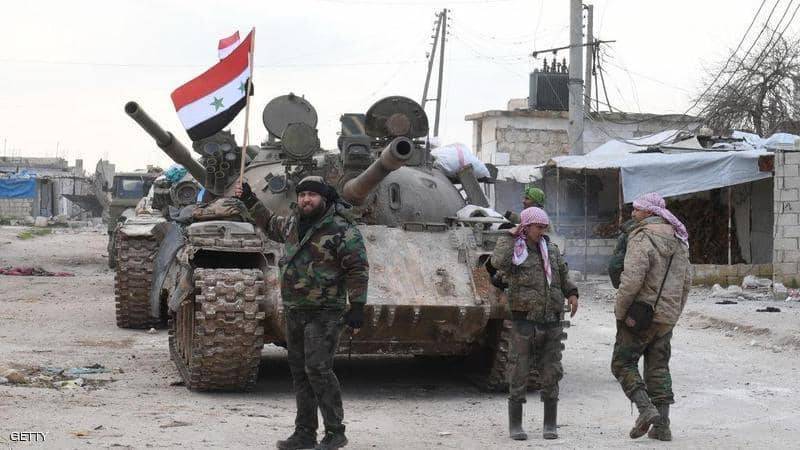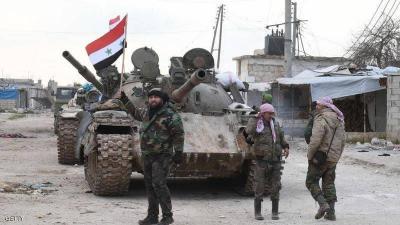Under the title "Daraa Clashes: A New Escalation of the Syrian Conflict or Its End?", Sky News published a report noting that while the return of clashes in recent days in Daraa, southern Syria, recalls the beginnings of the war that ignited there in 2011, analysts predict that the end of this war may be written in Daraa itself, especially with the declining appetite of international actors to continue the conflict and the weakening military strength of opposition groups in the area, in addition to President Bashar al-Assad winning a fourth term.
With talks of an upcoming meeting between the Syrian government and the central committee in Daraa (representing the opposition in the city) under Russian auspices, armed groups are preparing to fight following the Fourth Division of the Syrian army's attempt to advance from the Sijna area to the Kaziah checkpoint, which separates areas under government control from the besieged Daraa al-Balad areas, amidst continued heavy artillery and mortar shelling.
On July 29, military escalation began between the Syrian army and rebels in the eastern countryside, the city, and the western countryside due to the failure of an agreement reached days earlier between the government and the rebels mediated by Moscow to end the siege imposed since June on neighborhoods of Daraa al-Balad, consisting of six points, including handing over weapons, settling the status of some militants, and the withdrawal of stationed forces from the besieged area to military points in the old customs, Shiyah, and Al-Barid areas.
The government and local committees exchanged accusations regarding the breach of the agreement. According to local sources in Daraa, the Syrian army continued shelling their areas while demanding the surrender of all weapons despite the exit of wanted militants. Conversely, government forces indicate that some militants belong to ISIS, which means their presence poses a threat to the full return of security to southern Syria and hinders the process of civilian return and city reconstruction.
The significance of the Daraa al-Balad neighborhood lies in its location between the eastern and western countryside of the province and its proximity to the Nasib border crossing with Jordan and the international road leading to it.
**Reasons for Escalation**
Political researcher Ahmad Al-Alyba attributes the escalation to differing visions among the parties regarding the settlement agreement signed in 2018. The government views it as a disruption of the balance of power in favor of its adversaries among the rebels and the central committee in Daraa due to their presence in 25 points within the province.
He explains to "Sky News Arabia" that the second reason relates to Daraa’s dissatisfaction with President Bashar al-Assad's election for a fourth term last May, as it symbolizes the initial protests against him that erupted in March 2011. Additionally, the government's desire for complete control over the country, supported by its allies (Iran and Hezbollah), is evidenced by their policy of territorial encroachment and imposing a siege on areas under Kurdish control while constructing an Iranian consulate in Aleppo.
**Incompatibility of Syrian and Russian Positions**
It seems that the Syrian and Russian stances regarding Daraa this time are not aligned. Russia has been playing the role of mediator from the outset of negotiations through a Russian officer known as "Asadullah," who presented the government's demands to relocate five militants to northern Syria and surrender light weapons.
Al-Alyba indicates that Damascus has put the Russians in a "critical position" by taking a preemptive move and assigning the army to withdraw weapons and expel the militants, leading to renewed fighting. This is evident as the Russian reconciliation center has not issued any official statement regarding the developments as negotiations have paused, especially since Moscow considers international and regional power balances in its negotiation calculations, not just the Syrian government, according to Al-Alyba.
Local sources have reported ongoing consultations to cease fire while the Syrian army continues to send military reinforcements for combat.
**End of the Crisis**
Strategic expert Brigadier General Samir Ragab forecasts that the Daraa clashes will become a decisive point in favor of the Syrian army and an end to the conflict, as the city itself marked the beginning ten years ago; the idea of toppling regimes through armed conflict has not succeeded with the army regaining its previous strength with Russian support and controlling a large area of the country.
Regarding the reason for the current escalation, he mentions in his talk with "Sky News Arabia" that Damascus resorts to clashes to pressure the central committee and militants to accept its demands, while the militants reject these demands fearing that the government's return would expose them to imprisonment. This necessitates the government to implement social and political measures alongside security measures to reassure them of their reintegration into society and to put an end to arms control.
**Calm on the Horizon**
Ahmad Al-Alyba's expectations align with this, stating that "if the clashes do not stop on the part of the central committees, which is the most likely scenario, Russia will resort to airstrikes while attempting negotiations with government forces." He adds, "As escalation continues for a while, all parties will incur losses, even the Russian intervention for negotiations, which benefits the regime due to its capability to restore all regions from militants willing to concede their demands to end the clashes."
Samir Ragab sees the possibility of a ceasefire occurring, especially since local committees in Daraa have no regional or international support, nor does the international community have the appetite to back them anymore; rather, it now leans towards reintegrating the Syrian regime.
Daraa is one of the areas under the de-escalation agreement signed in May 2017 during the Astana 4 negotiations between Russia, Iran, and Turkey, aimed at implementing a ceasefire for six months, extendable, to facilitate the return of civilians to their homes and the reconstruction of infrastructure. Before the government regained control of the province, it fell under the control of armed factions between 2012 and 2018, some of which pledged allegiance to ISIS.




